Experimental Investigation on Combustion Characteristics of Massage Chairs in Waiting Halls of High-Speed Railway Stations
Abstract
1. Introduction
2. Experimental Design
2.1. Experimental Method
2.2. Experimental Scenarios
3. Results and Analysis
3.1. Combustion Characteristics of Massage Chair Fire
3.2. Distribution of Temperature Field
3.3. Distribution of Radiation Heat Flux
4. Conclusions
- The combustion of full-scale massage chair fires exhibited obvious stage characteristics. Among them, the temperature rise and HRR in the growth stage increased fastest. The change in HRR in the incipient and growth stages of the massage chair combustion was consistent with t2 fast fire (with a growth coefficient of 0.04689). The t2 fast fire could be applied to the fire protection design of high-speed railway station waiting halls.
- The maximum the HRR of the SMC combustion test was 1.2 MW, the maximum HRR of the TWMC combustion test was 2.5 MW, and the maximum HRR of the THMC combustion test was 3.5 MW.
- In the case of the TWMC combustion test, the massage chair, at a distance of 1.5 m from the fire source, was not ignited but melted.
- In the full-scale massage chair combustion tests, setting up a 6.0 m isolation zone could effectively serve the functions of fire prevention and heat insulation. Taking into account a certain safety margin, with a safety factor of 1.5 specifically adopted for the calculation, it is recommended that a fire isolation zone with a width of 9.0 m be used in the waiting halls of high-speed railway stations.
Author Contributions
Funding
Institutional Review Board Statement
Informed Consent Statement
Data Availability Statement
Conflicts of Interest
References
- China Railway Statistical Bulletin for 2023, 28 June 2024. Available online: https://www.mot.gov.cn/tongjishuju/tielu/202407/P020240708579407135335.pdf (accessed on 5 June 2025).
- Wang, C.; Wu, Q.H.; Zhang, J.; Zhang, Z.D.; Wu, J.H. Startup and defrosting dynamic characteristics of the heat pump and its influence on horizontal scroll compressor reliability of high-speed train. Case Stud. Therm. Eng. 2025, 66, 105732. [Google Scholar] [CrossRef]
- Meng, S.; Zhou, D.; Chen, T. Study on Smoke Diffusion and Fire Ejection Behavior from Broken Windows of a High-Speed Train Carriage. Fire 2025, 8, 137. [Google Scholar] [CrossRef]
- Ou, C.; Xiao, N.Q.; Zhang, N.; Zhao, J.M. Full-scale experimental study on the burning and spreading characteristics of baggage fire in high-speed railway waiting hall. Fire Sci. Technol. 2024, 43, 971–975. [Google Scholar]
- Xie, Q.Y.; Zhang, H.P.; Han, Z.F.; Mei, P. Full-scale study on combustion characteristics of an upholstered chair under different boundary conditions—Part 1: Ignition at the seat center. Fire Mater. 2009, 33, 287–302. [Google Scholar] [CrossRef]
- ISO 9705; Fire Tests–Full-Scale Room Test for Surface Products. International Organization for Standardization: Geneva, Switzerland, 1993.
- Xie, Q.Y.; Zhang, H.P.; Han, Z.F.; Mei, P. Full-scale study on combustion characteristics of an upholstered chair under different boundary conditions—Part 2: Ignition at the backrest top. Fire Mater. 2011, 35, 539–551. [Google Scholar] [CrossRef]
- Shi, C.; Peng, L.C. Fire safety evaluation of chairs in olympic gymnasium. Sci. Technol. Rev. 2008, 29, 34–39. [Google Scholar]
- Lu, S.C.; Ni, Z.P.; Kan, Q.; Wang, G.; Guo, W.; Huang, Y.L. Fire tests on chairs used in the stadium of the 26th summer unversiade. Fire Saf. Sci. 2012, 21, 189–196. [Google Scholar]
- Yang, X.H.; Guo, H.D.; Yin, C.L.; Deng, L.; Guo, G.J. Experimental study on combustion behavior of cinema seats row. Fire Saf. Sci. 2021, 40, 160–163. [Google Scholar]
- Ma, Y.; Gu, M.; Yang, W. Numerical simulation research on electrical fire of multifunctional waiting seat in high-speed railway station. Mod. Inform. Technol. 2021, 5, 77–83. [Google Scholar]
- Yang, W.; Ma, Y.; Gu, M. Radiation analysis of multifunctional waiting seat fire in high speed railway stations based on FDS. Technol. Mark. 2022, 29, 89–92. [Google Scholar]
- Gu, S.N.; Bu, X.M.; Yang, Z.J. Experimental study on combustion characteristics of single and row multifunctional massage seats. Fire Sci. Technol. 2023, 42, 1180–1186. [Google Scholar]
- Zhu, J.; Li, X.J.; Mie, C.F. Combustion performance of flame–ignited high-speed train seats via full-scale tests. Case Stud. Fire Saf. 2015, 4, 39–48. [Google Scholar] [CrossRef][Green Version]
- Yang, L.; Zhao, J.; Zhu, Y.L. Experimental study on fire performance of common vehicle seat. Fire Sci. Technol. 2016, 35, 1533–1536. [Google Scholar][Green Version]
- Li, M.; Deng, B.L.; Huang, Y.P. Study on combustion characteristics of automobile seat materials. Fire Sci. Technol. 2020, 39, 912–915. [Google Scholar][Green Version]
- Mitrengaa, P.; Osvaldová, L.M.; Marková, I. Observation of fire characteristics of selected covering materials used in upholstered seats. Transp. Res. Procedia 2021, 55, 1775–1782. [Google Scholar] [CrossRef]
- Jang, H.L.; Kwon, T.S.; Kang, S.W.; Choi, K. Flame Resistance Performance of Silicone Pad for Application in Railway Industry. Fire 2024, 7, 255. [Google Scholar] [CrossRef]
- Hohenwarter, D. Review of Fire Tests on Seats for Passenger Coaches and the Materials Used in Them. Fire 2025, 8, 32. [Google Scholar] [CrossRef]
- ASTM E1354-17; Standard Test Method for Heat and Visible Smoke Release Rates for Materials and Products Using an Oxygen Consumption Calorimeter. American Society for Testing Materials: West Conshohocken, PA, USA, 2022.
- ISO 24473; Fire Tests–Open Calorimetry–Measurement of the Rate of Production of Heat and Combustion Products for Fires of up to 40 MW. International Organization for Standardization: Geneva, Switzerland, 2008.
- GB/T27904-2011; Testing Method for Fire Characteristics of Furniture and Subassemblies Exposed to Flaming Ignition Source. National Standards of People’s Republic of China: Beijing, China, 2011.
- Zhang, X.L.; Shi, C.L.; Hu, L.H. Temperature profile of impingement flow in the corner between wall and inclined ceiling induced by gaseous fuel jet flame. Fuel 2020, 259, 116232. [Google Scholar] [CrossRef]
- Chen, J.F.; Zhong, M.H.; Qiu, P.Y.; Long, Z.; Cheng, H.H. A study of repeatability of hot smoke test in a subway station. Case Stud. Therm. Eng. 2023, 41, 102666. [Google Scholar] [CrossRef]
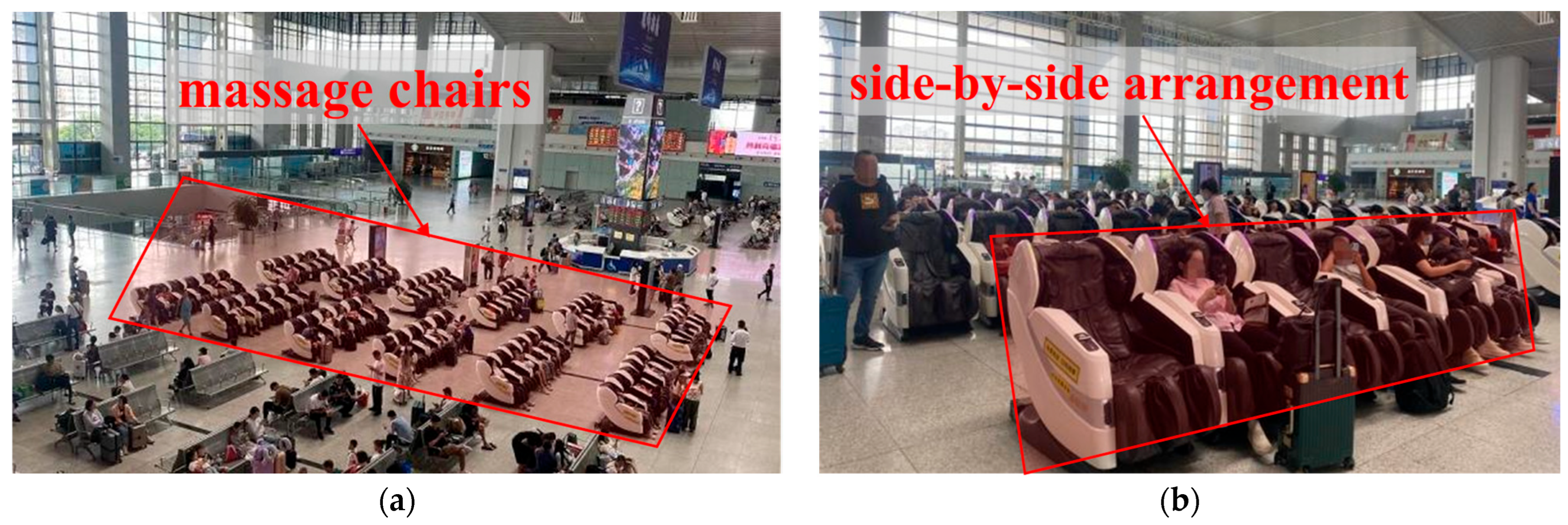


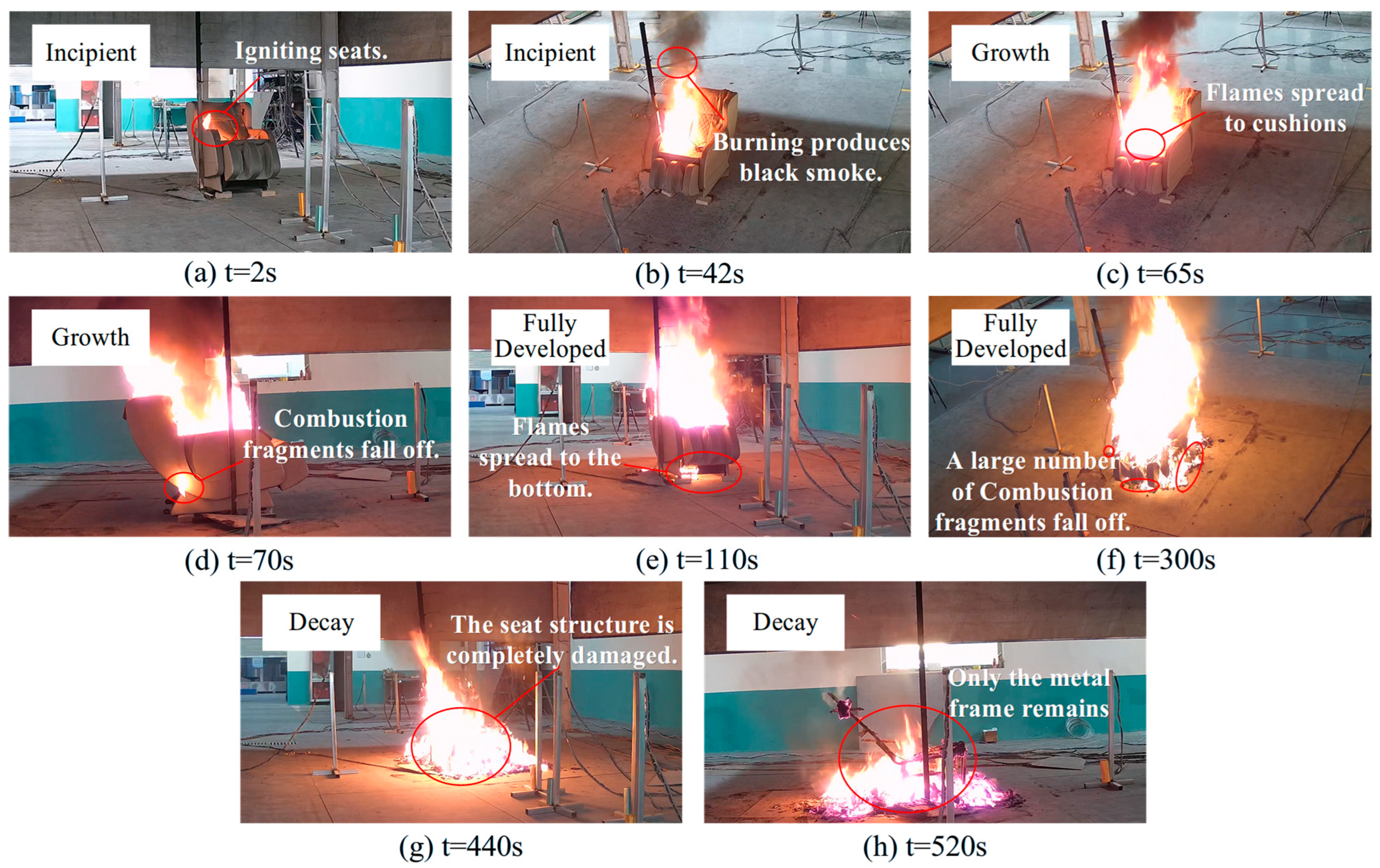
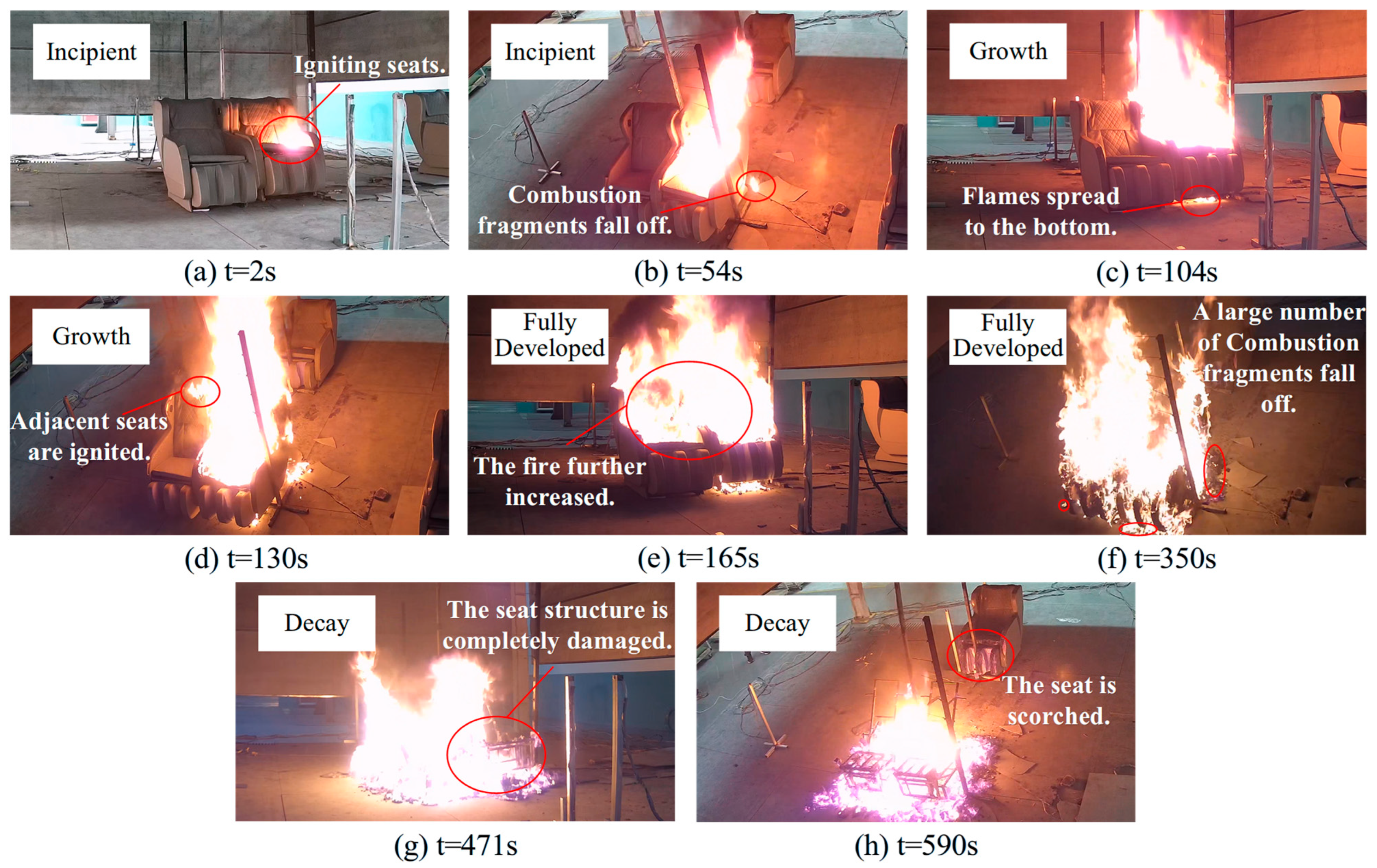
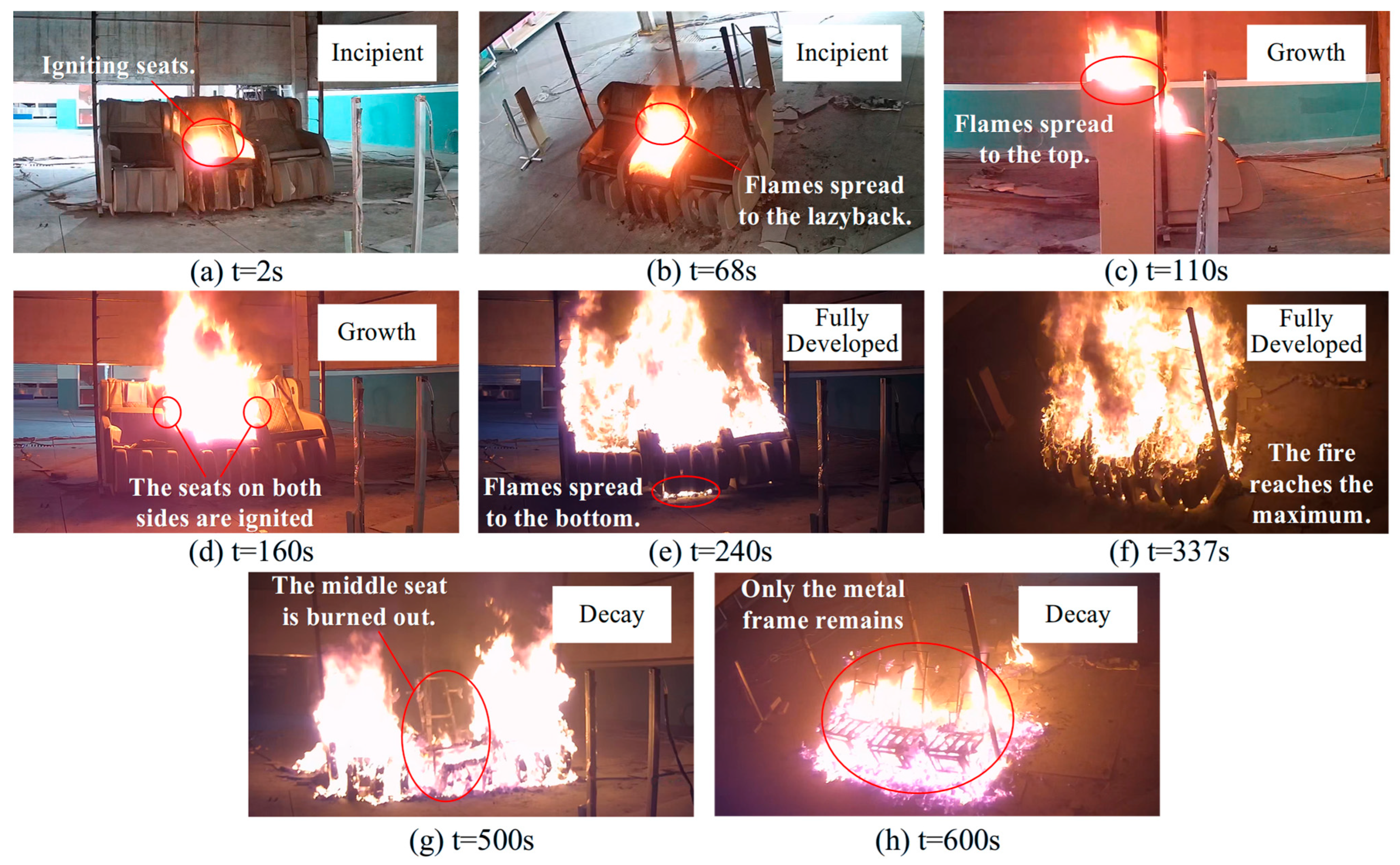
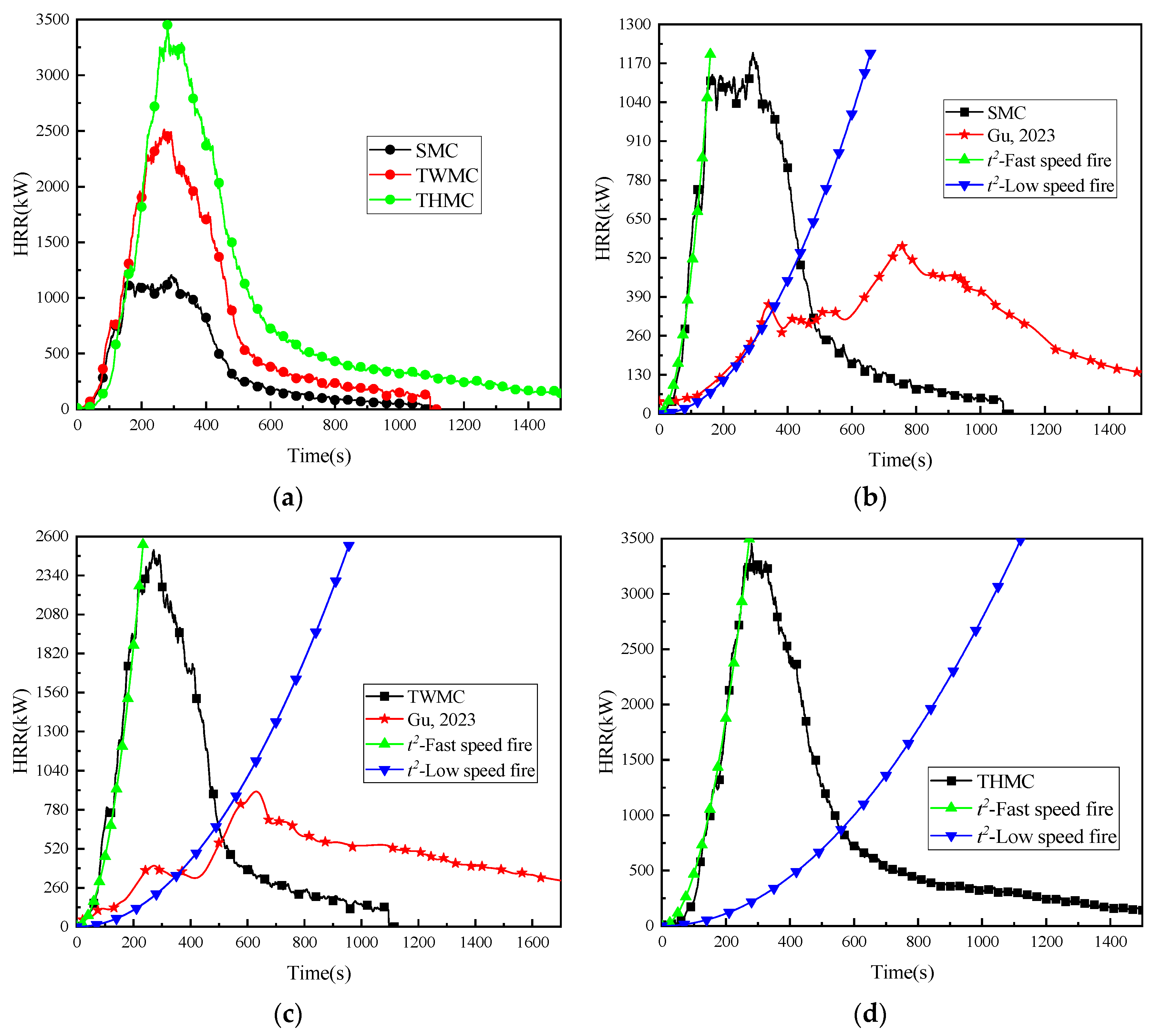
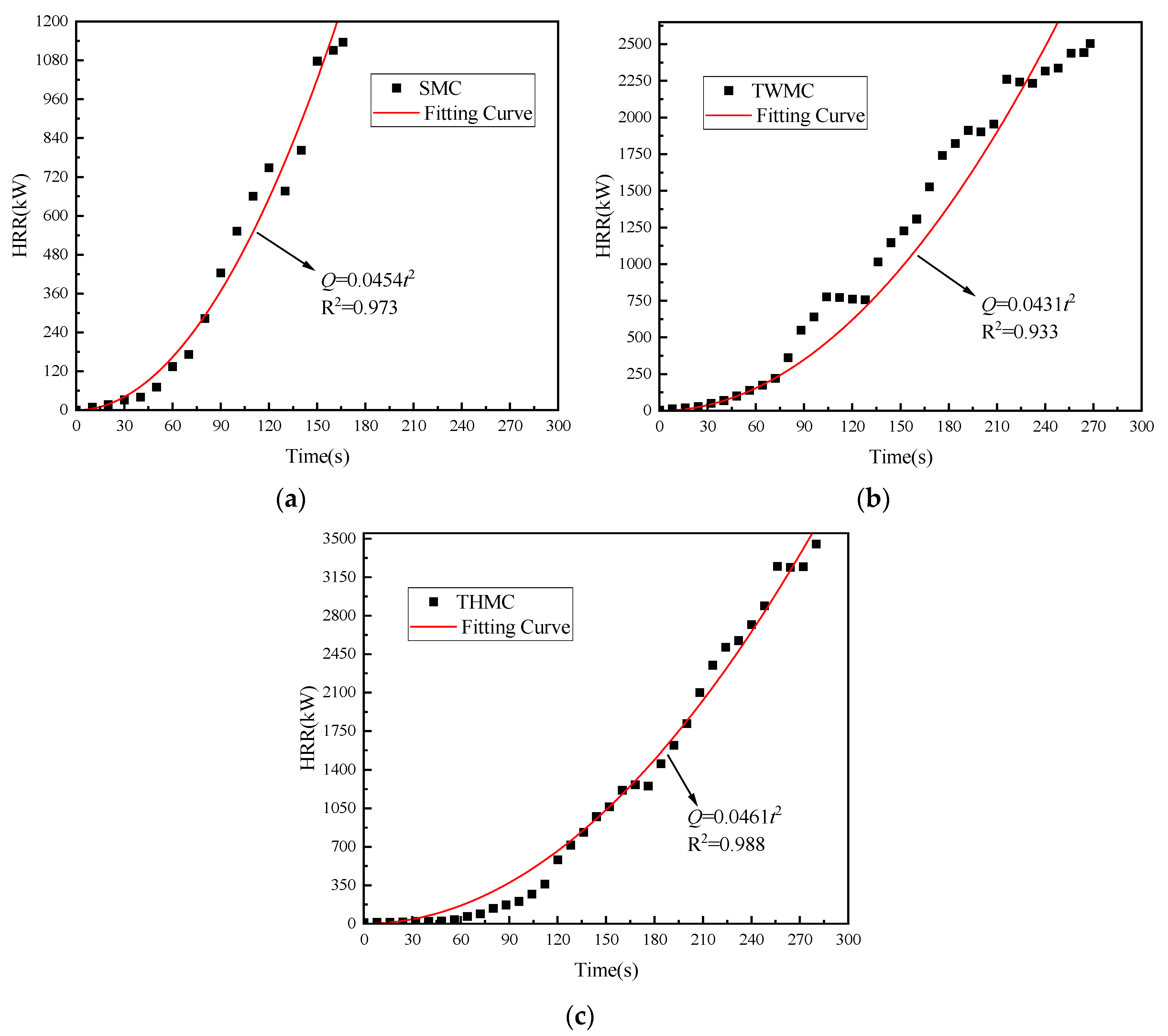
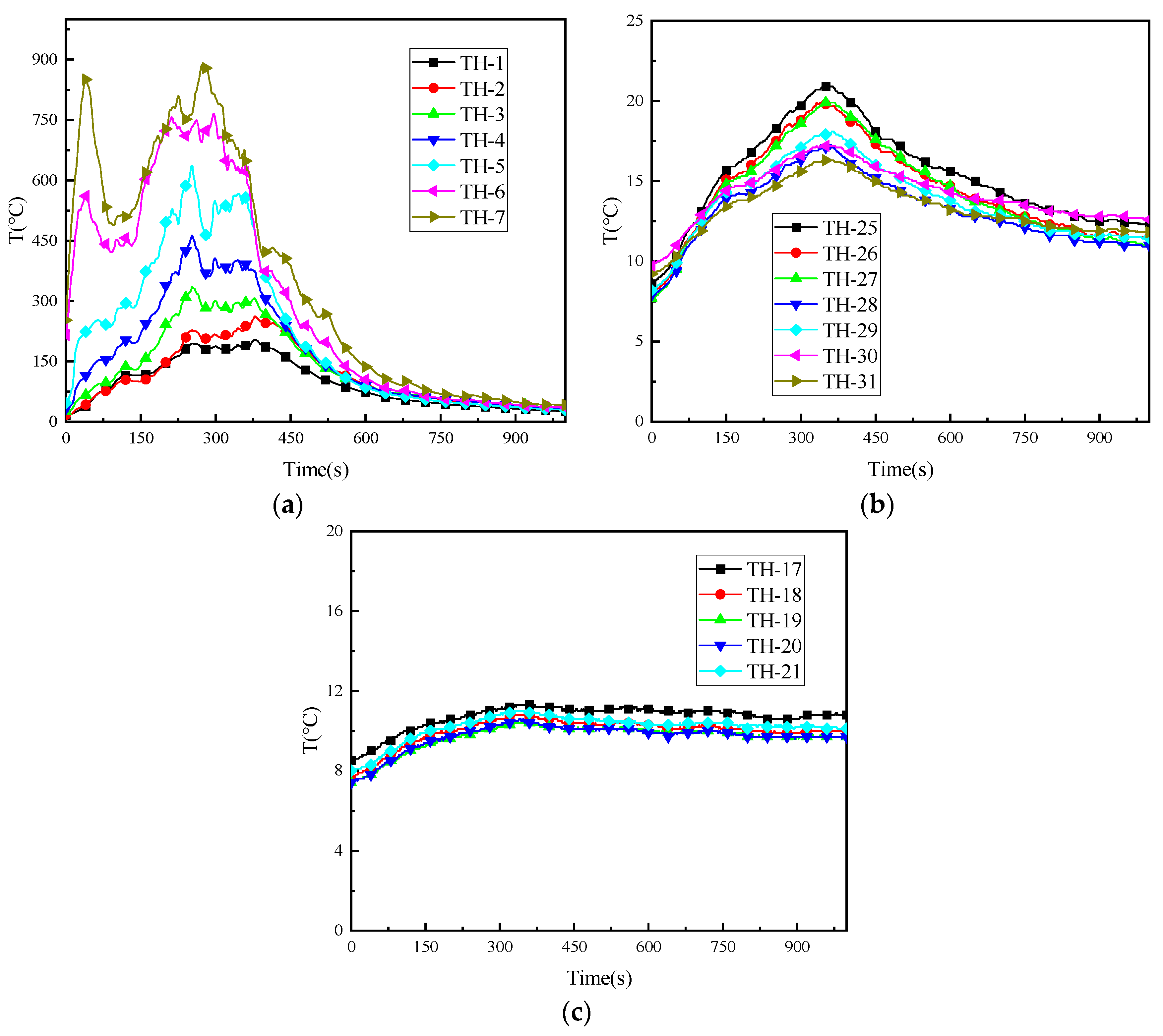
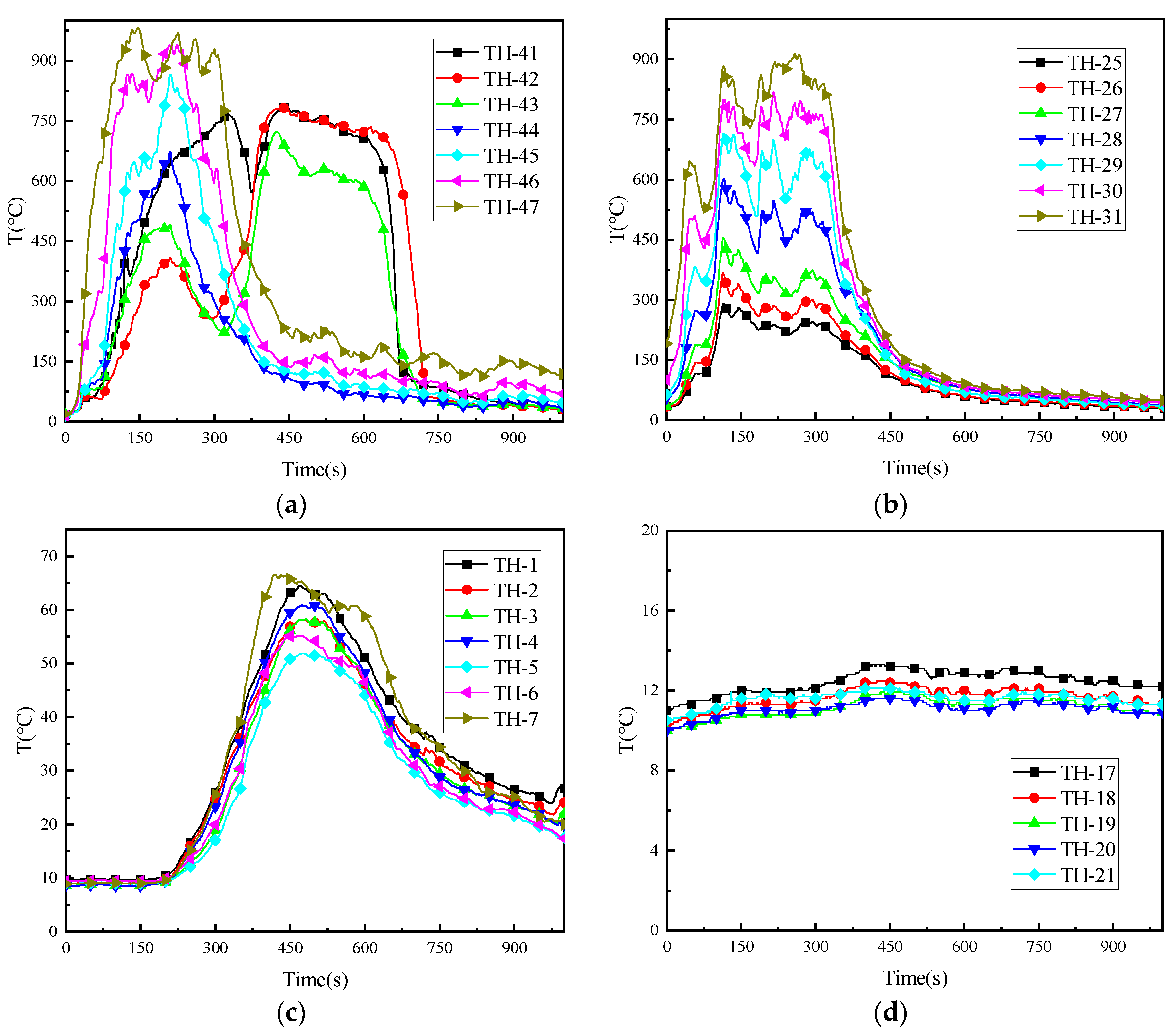
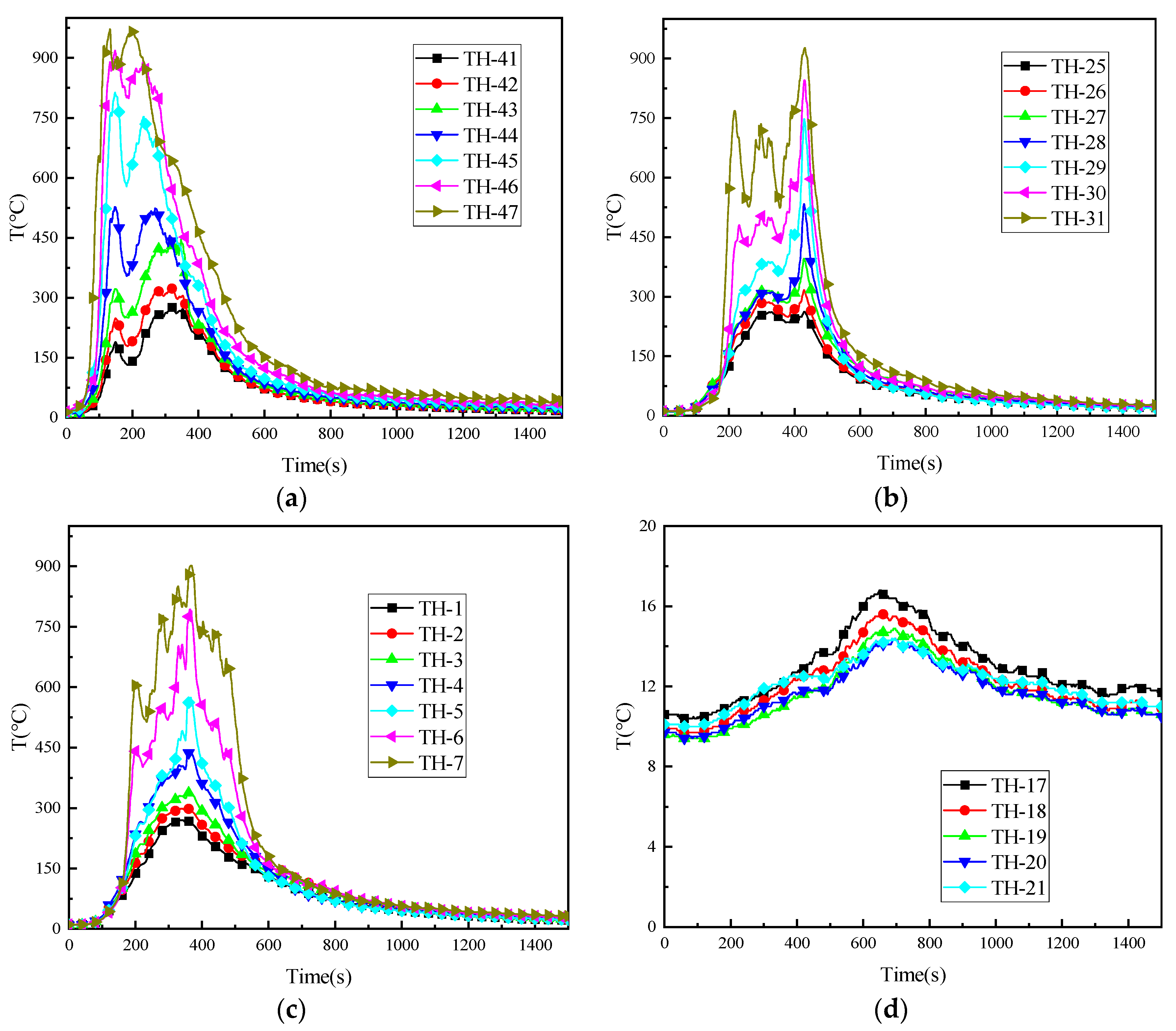
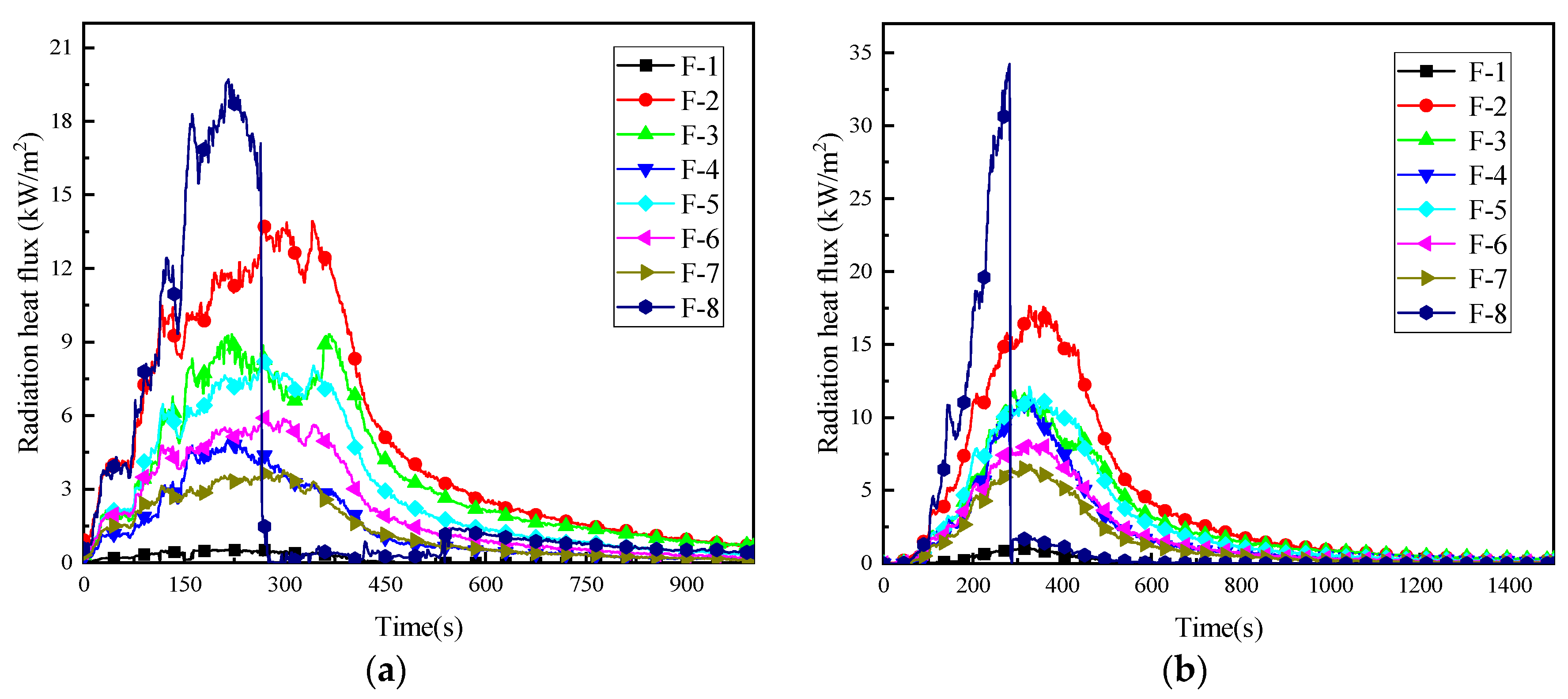
Disclaimer/Publisher’s Note: The statements, opinions and data contained in all publications are solely those of the individual author(s) and contributor(s) and not of MDPI and/or the editor(s). MDPI and/or the editor(s) disclaim responsibility for any injury to people or property resulting from any ideas, methods, instructions or products referred to in the content. |
© 2025 by the authors. Licensee MDPI, Basel, Switzerland. This article is an open access article distributed under the terms and conditions of the Creative Commons Attribution (CC BY) license (https://creativecommons.org/licenses/by/4.0/).
Share and Cite
Yang, X.; Wei, W.; Chen, Y.; Zhao, J.; Li, Y.; Zhang, C.; Feng, S. Experimental Investigation on Combustion Characteristics of Massage Chairs in Waiting Halls of High-Speed Railway Stations. Fire 2025, 8, 369. https://doi.org/10.3390/fire8090369
Yang X, Wei W, Chen Y, Zhao J, Li Y, Zhang C, Feng S. Experimental Investigation on Combustion Characteristics of Massage Chairs in Waiting Halls of High-Speed Railway Stations. Fire. 2025; 8(9):369. https://doi.org/10.3390/fire8090369
Chicago/Turabian StyleYang, Xiaodong, Wenbin Wei, Yujia Chen, Jiaming Zhao, Yanlong Li, Cheng Zhang, and Saiya Feng. 2025. "Experimental Investigation on Combustion Characteristics of Massage Chairs in Waiting Halls of High-Speed Railway Stations" Fire 8, no. 9: 369. https://doi.org/10.3390/fire8090369
APA StyleYang, X., Wei, W., Chen, Y., Zhao, J., Li, Y., Zhang, C., & Feng, S. (2025). Experimental Investigation on Combustion Characteristics of Massage Chairs in Waiting Halls of High-Speed Railway Stations. Fire, 8(9), 369. https://doi.org/10.3390/fire8090369






